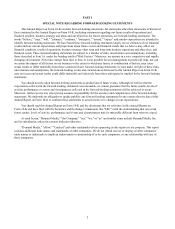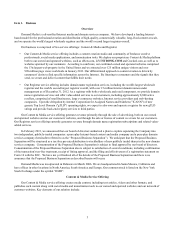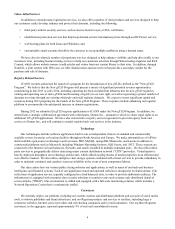Enom 2012 Annual Report Download - page 17
Download and view the complete annual report
Please find page 17 of the 2012 Enom annual report below. You can navigate through the pages in the report by either clicking on the pages listed below, or by using the keyword search tool below to find specific information within the annual report.12
likely seriously harm our business, revenue, financial condition and results of operations. There can be no assurance that we
will be able to compete successfully against current or future competitors.
We face intense competition from a wide range of competitors, including online marketing and media companies, social
media outlets, integrated social media platforms and other specialist and enthusiast websites. Our current principal competitors
include:
• Online Marketing and Media Companies. We compete with other Internet marketing and media companies, such as
AOL, IAC and various startup companies as well as leading online media companies such as Yahoo!, for online
marketing budgets. Most of these competitors compete with us across several areas of consumer interest, such as do-it-
yourself, health, home and garden, beauty and fashion, golf, outdoors and humor.
• Social Media Outlets. We compete with social media outlets such as Facebook, Twitter and Google+, where brands
and advertisers are focusing a significant portion of their online advertising spend in order to connect with their
customers.
• Integrated Social Media Applications. We compete with various software technology competitors, such as Jive
Software, in the integrated social media space where we offer our social media applications.
• Specialized and Enthusiast Websites. We compete with companies that provide specialized consumer information
websites, particularly in the do-it-yourself, health, home and garden, beauty and fashion, golf, outdoors and humor
categories, as well as enthusiast websites in specific categories, including message boards, blogs and other enthusiast
websites maintained by individuals and other Internet companies.
• Distributed Content Creation Platforms. We compete with companies that employ a content creation model with
aspects similar to our platform, such as the use of freelance creative professionals.
We may be subject to increased competition with any of these types of businesses in the future to the extent that they seek
to devote increased resources to more directly address the online market for the professional creation of commercially valuable
content at scale. For example, if Google chose to compete more directly with us, we may face the prospect of the loss of
business or other adverse financial consequences given that Google possesses a significantly greater consumer base, financial
resources, distribution channels and patent portfolio. In addition, should Google decide to directly compete with us in areas
such as content creation, it may decide for competitive reasons to terminate or not renew our commercial agreements and, in
such an event, we may experience a rapid decline in our revenue from the loss of our source for cost-per-click advertising on
our owned and operated websites and on our network of customer websites. In addition, Google's access to more
comprehensive data regarding user search queries through its search algorithms would give it a significant competitive
advantage over everyone in the industry, including us. If this data is used competitively by Google, sold to online publishers or
given away for free, our business may face increased competition from companies, including Google, with substantially greater
resources, brand recognition and established market presence.
In addition to Google, many of our current and other potential competitors enjoy substantial competitive advantages, such
as greater name recognition, longer operating histories, substantially greater financial, technical and other resources and, in
some cases, the ability to combine their online marketing products with traditional offline media such as newspapers or
magazines. These companies may use these advantages to offer products and services similar to ours at a lower price, develop
different products to compete with our current offerings and respond more quickly and effectively than we can to new or
changing opportunities, technologies, standards or customer requirements. For example, both AOL and Yahoo! may have
access to proprietary search data which could be utilized to assist them in their content creation processes. In addition, many of
our current and potential competitors have established marketing relationships with and access to larger customer bases. As the
markets for online and social media expand, we expect new competitors, business models and solutions to emerge, some of
which may be superior to ours. Even if our platform is more effective than the products and services offered by our
competitors, potential customers might adopt competitive products and services in lieu of using our services. For all of these
reasons, we may not be able to compete successfully against our current and potential competitors.
Our Content & Media service offering primarily generates its revenue from advertising, and the reduction in spending by or
loss of advertisers could seriously harm our business.
We generated 52% and 53%, respectively of our revenue for years ended December 31, 2011 and 2012 from advertising.
One component of our platform that we use to generate advertiser interest in our content is our system of monetization tools,
which is designed to match content with advertisements in a manner that optimizes revenue yield and end-user experience.
























